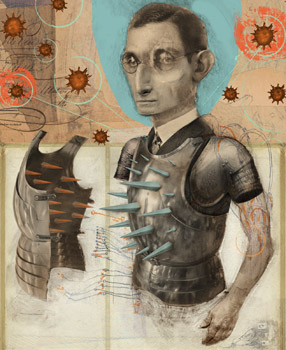FALL 2011 CONTENTS
Home
Game Change
On the verge of a revolution
Inside the labs
Highlighting recent Stanford cancer research
Cancer's biographer
A conversation with Siddhartha Mukherjee
The unexpected
Cancer during pregnancy
After cancer's cured
What's left to heal?
Make your own cancer diagnostic test
It's easier than you think

DOWNLOAD PRINTABLE
ISSUE (PDF)


Special Report
A good scare
Some stress could fight cancer
By Susan L. Young
Illustration by Lars Henkel
Stress can slow skin cancer, at least sometimes, and Firdaus Dhabhar, PhD, and his colleagues have the evidence to prove it.
But it’s not so simple. Dhabhar also has evidence that stress can hasten cancer.
You see, there’s stress and then there’s stress.
First, Dhabhar, associate professor of psychiatry and behavioral sciences, investigated the bad stress: chronic stress that goes on for weeks and months. This kind of stress reduces the immune system’s ability to fight diseases, including skin cancer, according to his mouse studies.
But the idea that all stress is bad didn’t add up for Dhabhar, who looks to nature for clues about health. Unlike chronic stress, an affliction mostly limited to modern man, acute stress is an important response to dangerous situations, the fight-or-flight rush felt when you’re chased by a tiger or, more realistically, in a near accident on the freeway. Acute stress sends immune cells coursing through your blood and on to their battle stations, ready for action if you are hurt. What’s more, Dhabhar had previously shown in humans that an adaptive, acute-stress response during surgery can speed recovery.
It’s reasonable, then, that acute stress might affect cancer differently, and could even help fight it. “Often, biology defeats pathology and we don’t even realize it,” says Dhabhar.
So he and his team studied how the immune-boosting effects of acute stress affected skin cancer. The researchers exposed hairless mice to about 10 minutes of UV-B light three times a week — each treatment akin to staying out a bit too long in the sun. For a short-term stress that mimicked the natural danger of a collapsed burrow, half the mice were placed in small, ventilated plastic tubes that restricted their movement for a couple hours before some UV sessions. After 10 weeks, the restrained rodents developed fewer tumors than the unstressed mice. The protection came from ramped-up defensive immune genes, and more immune cells invading the tumors of the stressed group.
While short-term stress helped, its protective effects didn’t last forever. After 22 weeks, nearly all animals had tumors, although the short-term stress group had fewer and smaller tumors until week 26, when the tumor burden evened between the two groups. Dhabhar’s lab is now investigating whether an acute-stress immune boost at later stages of tumor development is also protective.
If visions of oncologists prescribing public speeches and bungee jumping are floating through your head, you may want to know that Dhabhar hopes to find ways to behaviorally (think virtual reality or brief exercise) and pharmacologically mimic the good effects of acute stress. Other research from Dhabhar’s group has shown that stress hormones mediate the protective redistribution of immune cells to the skin. Now, he is teasing apart the molecular and cellular mechanisms of that redeployment. Those details could inform the amount, timing and location of hormones needed to mimic the acute-stress response in patients so doctors can best exploit nature’s immune-boosting system.
Dhabhar’s lab has also shown that chronic stress can suppress the beneficial acute-stress response. “Therefore, the key is to keep chronic stress levels low so the protective acute-stress response can spring into action when needed,” he says. So forgo your anxiety about that demanding boss or those bills. Save it for when the tiger comes to bite.

